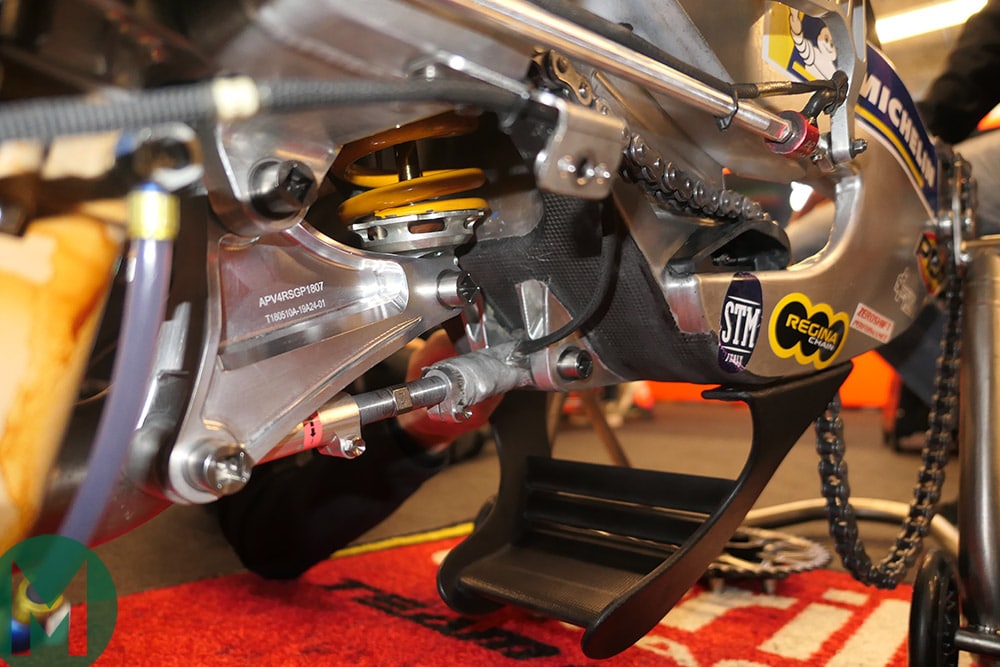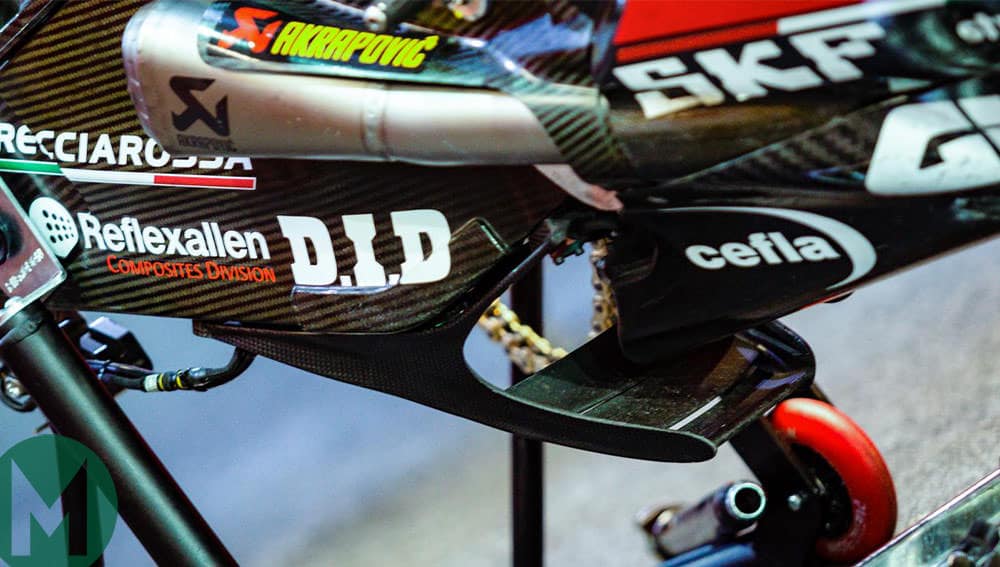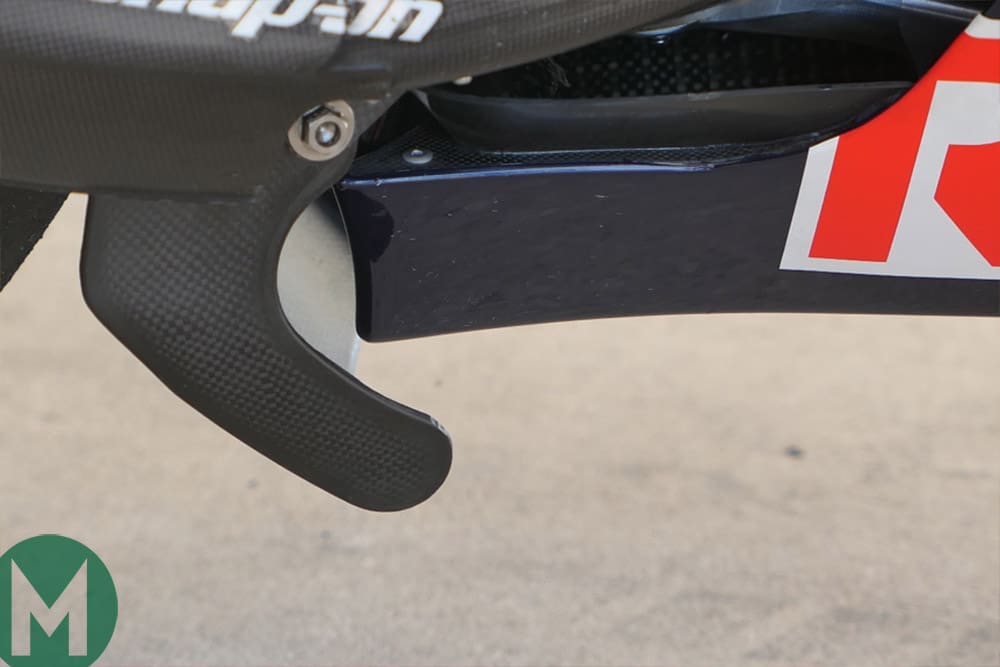
From Rosberg to Rovanperä - Motor sport's most shocking retirements
Led by the news of Kalle Rovanperä's unexpected decision to leave the WRC, we explore some of the most shocking retirements in motor sport history
MotoGP’s aero war is raging, with Aprilia the latest to fit a swingarm device, so what’s next for the rules? Should aero stay or should it go?

Photo: Aprilia RS-GP, COTA, Mat Oxley
These words you are reading are not part of a MotoGP article, they are the opening sentences of the first chapter of War and Peace by Leo Tolstoy.
The photo you see above is not an aerodynamic device attached to Aprilia’s RS-GP MotoGP bike for the first time during Monday’s private test at the Circuit of The Americas, it is a tyre cooler, or a swingarm stiffener, or a debris deflector, or possibly a hat.
MotoGP finds itself in a strange place at the moment, when words mean more than reality. Or perhaps the people in charge are suffering from a severe case of visual agnosia, an unusual neurological condition that leaves people unable to recognize even familiar objects.
The famous neurologist Oliver Sacks wrote a book about his experiences with patients suffering from visual agnosia. The book was titled “The Man Who Mistook His Wife for a Hat”.
In MotoGP’s scrutineering bays and even in its Court of Appeal in Switzerland, officials are examining the latest gizmos fitted to MotoGP bikes and failing to correctly identify what they see in front of them.
“If the manufacturers would agree we would literally ban all attachments, but it has to be agreed by all of them,”
During the recent Court of Appeal case to decide the fate of Ducati’s swingarm widget used in the season-opening Qatar GP, officials agreed with Ducati staff that the device was a tyre cooler and not an aerodynamic device designed to increase downforce and therefore rear grip.
Once the device had been declared legal it was obvious that rival manufacturers would make their own swingarm aero devices (sorry, tyre coolers), just as they had copied the Desmosedici’s winglets in 2016.
The first team to fit its own swingarm aero device (sorry, swingarm stiffener) at a race was Repsol Honda, which fitted the item to one of Marc Márquez’s RC213V during Friday’s FP2 session at COTA. The world champion immediately felt a difference.
“We tried something new on the swingarm, for stiffness,” he laughed. “In fact I did feel something interesting – one of the differences is at the brake point you can feel the downforce. I don’t think it makes a big difference to tyre temperature! But we need to check the data, analyse and understand.”
Saturday’s stormy weather, which forced the cancellation of FP3, prevented Marquez from further testing the device. Perhaps if he had used it in the race, he would’ve been able to get his bike stopped better as he stormed into Turn 12 on lap nine.
More: MotoGP Mutterings: 2019 Grand Prix of the Americas
Aprilia tested its own swingarm attachment on Monday and it’s more than likely that rival factory engineers are now working hard in their own CFD programmes to get their devices ready for the next race at Jerez or the post-race tests.
Márquez’s comments confirmed the opinion of most aerodynamicists who have examined the Ducati device. I see nothing wrong with the new creations and I admire Ducati Corse for finding a gap in the regulations. But it is vitally important that MotoGP quickly gets on top of the aerodynamics situation before there’s more confusion, more protests and more visual agnosia.
Very soon all the manufacturers in the MSMA will sit around a table with Dorna, IRTA and the FIM to thrash out a way forward. The problem, of course, is that the difference in opinion between the factories is so wide. KTM wants to ban all aero and revert to old-school bodywork, while Ducati only sees benefits in exploring this new area of technology. Aprilia, Honda, Suzuki and Yamaha are somewhere in the middle.

Photo: Ducati GP19, Qatar, Mat Oxley
So who will get their way? Possibly KTM.
“If the manufacturers would agree we would literally ban all attachments, but it has to be agreed by all of them,” said MotoGP’s technical director Danny Aldridge at COTA. “I don’t know about Ducati – they might agree but it won’t happen until 2021 or 2022. That might be the compromise.
“This week we hope to give an updated proposal to the manufacturers that changes the wording of the aero regulations,” added Aldridge. “We won’t ban what they’ve already got, but we will clarify things and clear up some grey areas.”
The obvious problem in trying to make any major changes to the regulations is that the MSMA must agree unanimously before the rules are written into the rulebook. And how will that happen when Ducati and KTM are 180 degrees apart?
The last time MotoGP’s rulebook caused such a headache was some years ago when Dorna was trying to convince the factories to abandon their prized electronics R&D and adopt same-for-all software for traction control and other rider controls.

Photo: Honda RC213V, COTA, Mat Oxley
The big factories hated this idea, because there is no more important area of technological development than electronics. Some factories even threatened to quit MotoGP if Dorna pushed ahead with its plan and move to World Superbikes, then owned by Italian company Infront Sports.
On this occasion, Dorna lucked out. In 2011 Dorna’s private-equity owners Bridgepoint bought Infront, mainly for its football TV assets, run by Philippe Blatter, nephew of Sepp – former president of FIFA. World Superbikes was included in the Infront purchase, so Bridgepoint put Dorna in charge of WSB. Suddenly the factories had nowhere to run and had to sign up to Dorna’s unified software regulations.
This time what will it take for Aprilia, Ducati, Honda, KTM, Suzuki and Yamaha to agree?

Led by the news of Kalle Rovanperä's unexpected decision to leave the WRC, we explore some of the most shocking retirements in motor sport history

With Marc Márquez and José Antonio Rueda crowned MotoGP and Moto3 champions, Spanish riders could secure a clean sweep of the top motorcycle world championships. Adam Wheeler speaks to the Moto2 championship leader who can make it happen

It’s a strange day when the MotoGP winner is a rookie and the winner of the last race looks like a rookie. So what the hell is going on? Ducati finally tells us the reasons behind Bagnaia’s downfall, while Fermín Aldeguer takes an astonishing first victory

Marc Márquez's triumphant 2025 season reached its emotional high in Motegi, but will he one day meet his match in the direct, determined, and searingly quick Pedro Acosta?